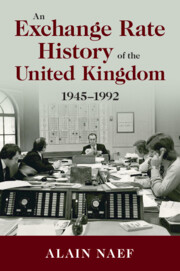Refine search
Actions for selected content:
26946 results in Economic history
9 - The 1964–1967 Currency Crisis
-
- Book:
- An Exchange Rate History of the United Kingdom
- Published online:
- 23 September 2022
- Print publication:
- 29 September 2022, pp 127-147
-
- Chapter
-
- You have access
- Open access
- HTML
- Export citation
Index
-
- Book:
- Wealth, Land, and Property in Angola
- Published online:
- 22 September 2022
- Print publication:
- 29 September 2022, pp 313-323
-
- Chapter
- Export citation
1 - Sterling’s Post-War Role and Lessons from the 1947 Convertibility Crisis
-
- Book:
- An Exchange Rate History of the United Kingdom
- Published online:
- 23 September 2022
- Print publication:
- 29 September 2022, pp 5-17
-
- Chapter
-
- You have access
- Open access
- HTML
- Export citation

An Exchange Rate History of the United Kingdom
- 1945–1992
-
- Published online:
- 23 September 2022
- Print publication:
- 29 September 2022
-
- Book
-
- You have access
- Open access
- Export citation

Wealth, Land, and Property in Angola
- A History of Dispossession, Slavery, and Inequality
-
- Published online:
- 22 September 2022
- Print publication:
- 29 September 2022
3 - Between Independence and Impunity
- from Part I - Preface
-
- Book:
- Impunity and Capitalism
- Published online:
- 08 September 2022
- Print publication:
- 15 September 2022, pp 104-132
-
- Chapter
- Export citation
Tables
-
- Book:
- Impunity and Capitalism
- Published online:
- 08 September 2022
- Print publication:
- 15 September 2022, pp viii-viii
-
- Chapter
- Export citation
Acknowledgments
-
- Book:
- Impunity and Capitalism
- Published online:
- 08 September 2022
- Print publication:
- 15 September 2022, pp ix-xii
-
- Chapter
- Export citation
Part II - Preface
-
- Book:
- Impunity and Capitalism
- Published online:
- 08 September 2022
- Print publication:
- 15 September 2022, pp 133-214
-
- Chapter
- Export citation
1 - Professionalizing Impunity
- from Part I - Preface
-
- Book:
- Impunity and Capitalism
- Published online:
- 08 September 2022
- Print publication:
- 15 September 2022, pp 35-62
-
- Chapter
- Export citation
Bibliography
-
- Book:
- Impunity and Capitalism
- Published online:
- 08 September 2022
- Print publication:
- 15 September 2022, pp 274-302
-
- Chapter
- Export citation
Introduction
-
- Book:
- Impunity and Capitalism
- Published online:
- 08 September 2022
- Print publication:
- 15 September 2022, pp 1-24
-
- Chapter
- Export citation
2 - The Crisis of 1720 and the Invention of Discredit
- from Part I - Preface
-
- Book:
- Impunity and Capitalism
- Published online:
- 08 September 2022
- Print publication:
- 15 September 2022, pp 63-103
-
- Chapter
- Export citation
4 - The End of the Old Financial Regime, 1781–1793
- from Part II - Preface
-
- Book:
- Impunity and Capitalism
- Published online:
- 08 September 2022
- Print publication:
- 15 September 2022, pp 141-176
-
- Chapter
- Export citation
Part I - Preface
-
- Book:
- Impunity and Capitalism
- Published online:
- 08 September 2022
- Print publication:
- 15 September 2022, pp 25-132
-
- Chapter
- Export citation
Conclusion
- from Part III - Preface
-
- Book:
- Impunity and Capitalism
- Published online:
- 08 September 2022
- Print publication:
- 15 September 2022, pp 260-273
-
- Chapter
- Export citation
Figures
-
- Book:
- Impunity and Capitalism
- Published online:
- 08 September 2022
- Print publication:
- 15 September 2022, pp vi-vi
-
- Chapter
- Export citation
6 - The Panic of 1825 and the Systematization of Impunity
- from Part III - Preface
-
- Book:
- Impunity and Capitalism
- Published online:
- 08 September 2022
- Print publication:
- 15 September 2022, pp 219-259
-
- Chapter
- Export citation
Contents
-
- Book:
- Impunity and Capitalism
- Published online:
- 08 September 2022
- Print publication:
- 15 September 2022, pp v-v
-
- Chapter
- Export citation
Index
-
- Book:
- Impunity and Capitalism
- Published online:
- 08 September 2022
- Print publication:
- 15 September 2022, pp 303-310
-
- Chapter
- Export citation
